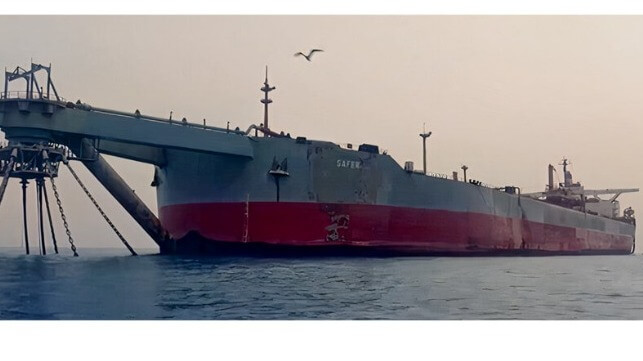UN Struggles to Find Tanker for Oil Transfer from FSO Safer off Yemen

UN officials reported the latest hurdle in their plan to remove the oil stored on a decaying tanker off the coast of Yemen is finding and affording a tanker to receive the oil. In a briefing at UN headquarters, they said they are making good progress both in the financing and planning for the effort, but that the cost and availability of tankers is their latest challenge. France earlier this week said it was increasing its financial contribution to help with the increased cost of the plan.
“The availability of very large crude carriers has decreased in the past six months, basically due to events having to do with the war in Ukraine,” said Farhan Haq, Deputy Spokesperson for the UN Secretary-General. “So, just as we were gearing up for operations, the cost to both lease and purchase this type of vessel increased. A very large crude carrier now costs about 50 percent more than what's budgeted in the original plan. So, we have some additional expenses and it's a little bit harder finding the right ships, but we're proceeding with the work.”
After prolonged negotiations between all the factions, the UN reached an agreement that calls for the transfer of the oil from the FSO Safer to a replacement tanker until a permanent storage solution can be reached. The Safer is a 1970s-vintage oil tanker that was converted into an FSO in 1987, but work on the vessel stopped in 2015 due to the civil war. There are over one million barrels of oil stored aboard while only a skeleton crew with limited resources has been left to hold the systems together and prevent a catastrophic oil spill.
“All of the technical expertise is in place to undertake the procurement for the complex operation,” Hag said during the January 17 press briefing. “This includes a marine management consultancy firm, maritime legal firm, insurance and ship brokers, and oil spill experts. The contracting of the salvage company that will carry out the emergency operation is at an advanced stage.”
The UN is working with a maritime broker and other partners to find a workable solution for the tanker to store the oil. The plan called for temporary storage until a permanent solution was provided to the Houthi rebels which claim the oil as their property because of their control of the oil region and area where the ship is anchored off Yemen. The UN says it remains confident the work can begin in the coming months.
The French government responded to the latest developments by increasing its contribution to the UN-led rescue plan. France is making an extra contribution of €1 million bringing its total contribution to €2.26 million (nearly $2.5 million).
A French Foreign Ministry statement said that increasing its funding commitments to the Safer’s rescue plan illustrates the country’s commitment to protecting the environment in the Red Sea region and its steadfast support for the UN-led rescue plan. “France calls on the Houthis, who currently control the Safer tanker, to cooperate fully with the United Nations on the implementation of the rescue plan,” said the statement.
The UN reports to date it has received $73 million of the pledges that total more than $84 million coming from countries, corporations, and individuals in a crowdfunding campaign. Haq said that additional funding from the private sector is expected soon, and with the pledges received the UN has been able to begin essential preparatory work.

that matters most
Get the latest maritime news delivered to your inbox daily.
Apart from funding for the emergency operation, the UN plan initially estimated that an additional $38 million would be required for the installation of safe long-term replacement capacity for the Safer during Phase II of the operation. The oil would remain in Yemen, while the Safer would be removed and sold for scrap with the proceeds used to partially offset the cost of the salvage operation.
The UN has warned that failure to act now would result in an oil spill whose impacts would be an environmental and humanitarian catastrophe cutting across the destruction of pristine reefs, coastal mangroves, and other sea life across the Red Sea, exposing millions of people to highly polluted air and cutting off food, fuel and other life-saving supplies to Yemen, a war-torn country where 17 million people already need food aid. Coastal communities would be hit hardest with hundreds of thousands of jobs in the fishing industry being lost. The UN estimates it would take 25 years for fish stocks to recover while the cost of cleanup alone would be a staggering $20 billion if the Safer were to rupture.
